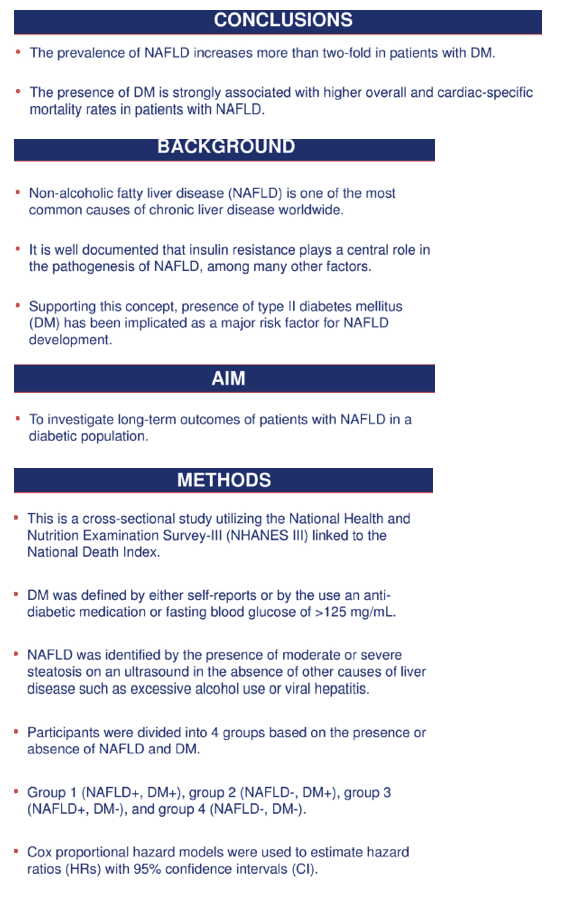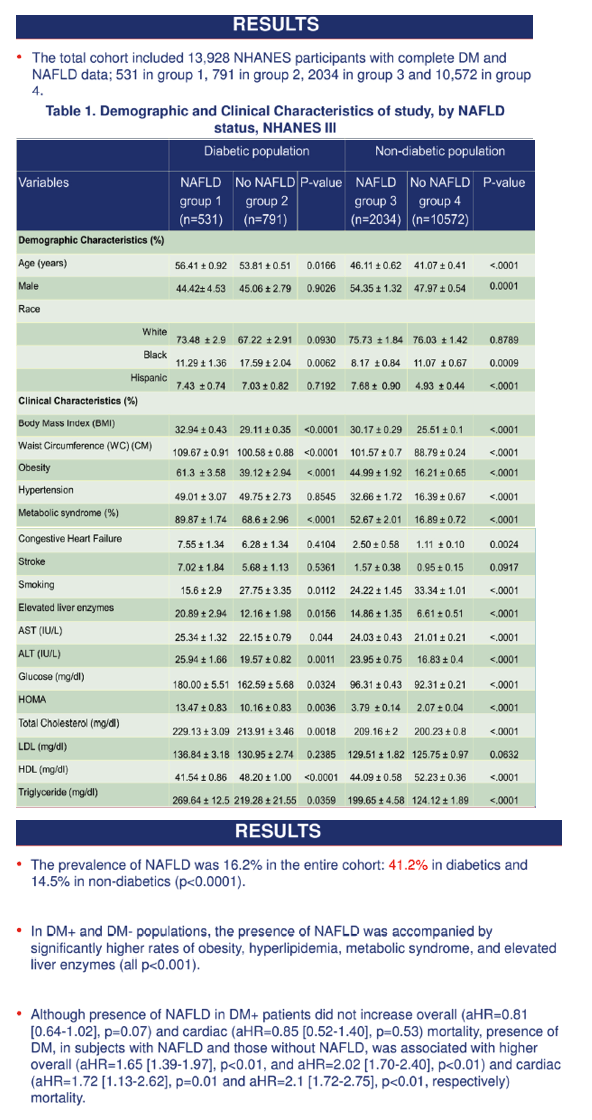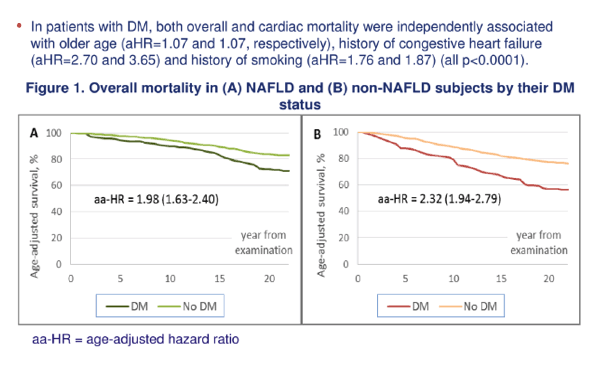| |
Long-Term Outcomes of Diabetic Patients with Non-alcoholic Fatty Liver Disease (NAFLD) / HIV & the Liver, Fatty Liver/NALFD
|
| |
| |
Reported by Jules Levin
AASLD 2017 Oct 20-24 Wash DC

-----------------------------------
HIV & Liver Disease & NASH, NAFLD: fatty liver......from Jules: here are recent studies highlighting fatty liver disease in HIV+. HIV itself can cause elevated liver enzymes & liver disease, reported by study just below, This is not new but the long term outcomes can be serious perhaps resulting in advanced liver disease as reported in this study where HIV+ also had metabolic syndrome, elevated lipids etc, and some also had fatty liver; but the long term outcome can be advancing liver disease, which often gets overlooked by clinicians in HIV and outside HIV but HIV+ appear to be at greater risk for these syndromes because HIV appears to be a contributor as well as elevated lipids/metabolic syndrome and some of the ARTs as well such as some nucleosides and protease inhibitors. Some ARTs may be associated with fat deposition and fat fibrosis or abnormal fat metabolism, all these may also be associated with the increased cardiovascular risk and other comribidities as well in HIV+.
Elevated Liver Enzymes & Non-Viral Liver Disease (Cirrhosis) May Be Caused by HIV + Metabolic Syndrome
.......Of 425 HIV+ mono-infected individuals, 90 have been recruited to date. Baseline characteristics of those with and without CSHF [clinically significant hepatic fibrosis] were similar (Table 1). HS [hepatic steatosis: fatty liver] was seen in 46 (51.1%). Twenty (22.2%) had CSHF of whom 10 (50%) also had HS and four (20%) had cirrhosis (LSM >11.5kPa).
EACS: Non-viral Liver Disease Burden in HIV Mono-infected Individuals: A Prospective Cohort Study - (12/07/17)
EACS: How many HIV mono-infected or HBV or HCV co-infected patients with undetectable viremia should be monitored for liver disease severity in the presence of suspect NAFLD? - (12/08/17)
IAS: Predictor factors associated with liver fibrosis and steatosis by transient elastography in HIV mono-infected patients under long-term combined antiretroviral therapy - (07/26/17)
Its estimated 30-40% of HIV+ have fatty liver (NAFLD) and studies suggest these rates may be higher than in HIV-negatives. BUT here is a study finding 67% fatty liver in HCV/HIV coinfected .....67% Steatosis in HCV/HIV Coinfected: : Liver inflammation, HCV genotype 3, and BMI are associated with steatosis, a common finding in HCV-HIV-coinfected patients http://www.natap.org/2007/HIV/062007_02.htm
CROI: FATTY LIVER DISEASE: A GROWING CONCERN - - (04/12/17) a plenary talk by noted fatty liver expert Rohit Loomba from UCSD
CROI: Changes in Liver Fibrosis and Steatosis in HIV Mono-Infected patients over 24 months - 50% have fatty liver at average age of 46 - (03/28/17)
CROI: LIVER STEATOSIS AND FIBROSIS IN AT-RISK EUROPEAN HIV-MONOINFECTED PATIENTS - 64% with steatosis among those who had elevated LFTs and/or metabolic syndrome and/or lipodystrophy - (03/28/17)
EACS: Analysis of the performance of non-invasive markers of steatosis and fibrosis in HIV-monoinfected patients at-risk of NAFLD: Results from the ERANET-HIVERA ECHAM study - (11/15/17)
IAS: Fatty Liver in HIV+ at IAS - (08/05/17)
-----------------------
PROGRAM ABSTRACT
Background: Non-alcoholic fatty liver disease (NAFLD) is one of the most common causes of chronic liver disease worldwide. It is well documented that insulin resistance plays a central role in the pathogenesis of NAFLD, among many other factors. Supporting this concept, presence of type II diabetes mellitus (DM) has been implicated as a major risk factor for NAFLD development. However, the long-term outcomes of patients with NAFLD in a diabetic population have not been well studied.
Methods: This is a cross-sectional study utilizing the National Health and Nutrition Examination Survey-III (NHANES III) linked to the National Death Index. DM was defined by either self-reports or by the use an anti-diabetic medication or fasting blood glucose of >125 mg/mL. NAFLD was identified by the presence of moderate or severe steatosis on an ultrasound in the absence of other causes of liver disease such as excessive alcohol use or viral hepatitis. Participants were divided into 4 groups based on the presence or absence of NAFLD and DM: Group 1 (NAFLD+, DM+), group 2 (NAFLD-, DM+), group 3 (NAFLD+, DM-), and group 4 (NAFLD-, DM-). Cox proportional hazard models were used to estimate hazard ratios (HRs) with 95% confidence intervals (CI).
Results: The total cohort included 13,928 NHANES participants with complete DM and NAFLD data; 531 in group 1, 791 in group 2, 2034 in group 3 and 10,572 in group 4. The prevalence of NAFLD was 16.2% in the entire cohort: 41.2% in diabetics and 14.5% in non-diabetics (p<0.0001). As expected, in DM+ and DM- populations, the presence of NAFLD was accompanied by significantly higher rates of obesity, hyperlipidemia, metabolic syndrome, and elevated liver enzymes (all p<0.001). Although presence of NAFLD in DM+ patients did not increase overall (adjusted hazard ratio (aHR)=0.81 [95% CI=0.64-1.02], p=0.07) and cardiac (aHR=0.85 [0.52-1.40], p=0.53) mortality, presence of DM, in subjects with NAFLD and those without NAFLD, was associated with higher overall (aHR=1.65 [1.39-1.97], p<0.01, and aHR=2.02 [1.70-2.40], p<0.01) and cardiac (aHR=1.72 [1.13-2.62], p=0.01 and aHR=2.1 [1.72-2.75], p<0.01, respectively) mortality. In patients with DM, both overall and cardiac mortality were independently associated with older age (aHR=1.07 and 1.07, respectively), history of congestive heart failure (aHR=2.70 and 3.65) and history of smoking (aHR=1.76 and 1.87) (all p<0.0001).
Conclusions: This study revealed that the prevalence of NAFLD increases more than two-fold in patients with DM. The presence of DM is strongly associated with higher overall and cardiac-specific mortality rates in patients with NAFLD.



| |
| |
| |
|
|
|